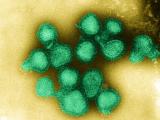Aug 6, 2009 (CIDRAP News) – In a revision of its advice for how long those who are sick with the novel H1N1 virus should stay away from others, the US Centers for Disease Control and Prevention (CDC) yesterday shortened the time period, which may reduce some of the pandemic's absence burden on businesses and schools.
The new exclusion guidance urges people with influenza-like illnesses to stay home at least 24 hours after they are free of a fever (in the absence of fever-reducing medication), defined as 100°F, which in most cases ranges from 3 to 5 days.
Earlier recommendations urged people to stay home for 7 days after illness onset or for 24 hours after symptoms resolve, whichever was longer. Besides businesses and schools, the guidance also applies to camps, mass gatherings, and other community settings.
However, the new recommendations do not apply to healthcare settings. People working or visiting healthcare facilities should still observe the earlier, longer-period exclusion guidance.
The CDC also emphasized that more stringent and longer exclusions may be needed for sick people who will return to settings where they have contact with people who have underlying medical conditions, such as camps for children with asthma or daycare centers that children younger than 5 attend.
"Decisions about extending the exclusion period should be made at the community level, in conjunction with local and state officials," the CDC said.
At a June teleconference that the CDC hosted for businesses in the wake of the World Health Organization's pandemic declaration, some businesses asked for clarifications on how long people with novel flu infections should stay home before returning for work.
Lisa Koonin, MN, MPH, a senior adviser with the CDC's influenza coordination unit who co-hosted the CDC business teleconference, told CIDRAP News today that the previous guidance was based on an early assessment of novel flu illnesses. She said the new recommendation is based on household contact studies. People seem to be most infectious the first day of a fever, which for most people goes away after 2 to 4 days.
Koonin said businesses and schools want to decrease absenteeism, but the CDC wanted to base any modification of its recommendations on scientific findings. "But if the outbreak becomes more severe, the CDC may recommend a longer exclusionary period because of the need to be more cautious," she said.
In its recommendation, the CDC said exclusion periods should apply even if antiviral medications are used and that when people return to work or school they should continue to observe respiratory etiquette and hand hygiene and avoid people who are in high-risk groups.
John Budd, PhD, chair of human resources and industrial relations at the University of Minnesota's Carlson School of Management, hinted that the new recommendations are likely to be well received by the business community. "The longer individuals are absent, the more disruptive it is for the workplace," he said.
See also:
Aug 5 CDC recommendations on duration of self-isolation
Jun 12 CIDRAP News story "Pandemic declaration prompts CDC huddle with businesses"



















